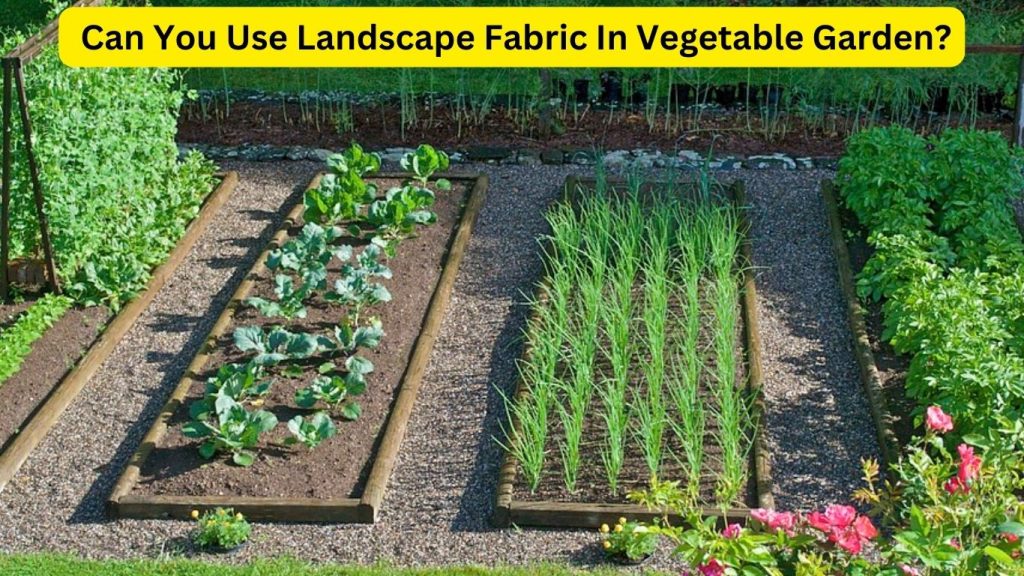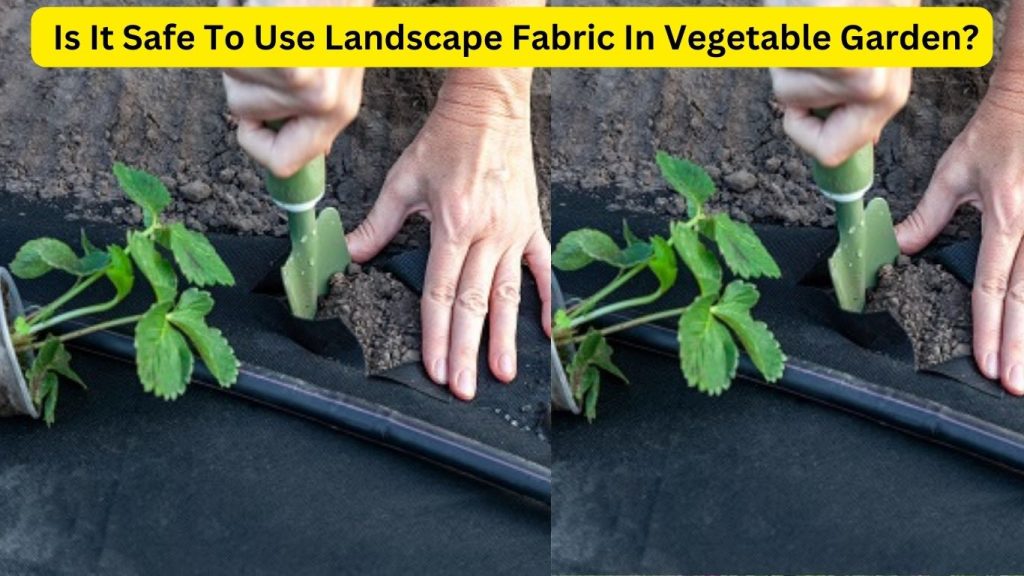Landscape fabric proves to be a valuable tool in cultivating a successful and thriving vegetable garden. This versatile material, typically made from woven or spun polypropylene, offers a range of benefits that enhance plant growth and garden maintenance.

By effectively suppressing weed growth, conserving soil moisture, and preventing erosion, landscape fabric provides a solid foundation for healthier vegetables.
Proper installation is key: clear the area of existing weeds and debris, level the soil and secure the fabric in place. Strategically cut holes for your desired plants, allowing them to flourish while enjoying the advantages of this efficient gardening aid.
Contents
Can You Use Landscape Fabric In Vegetable Garden?
Yes, you can use landscape fabric in a vegetable garden. Landscape fabric can be beneficial when used properly. It helps control weed growth, conserves soil moisture, and prevents erosion, all of which contribute to healthier vegetable plants.

To use landscape fabric effectively, prepare the area by clearing weeds and debris, leveling the soil, and laying down the fabric. Cut holes in the fabric for your vegetable plants, allowing them to grow while still benefiting from the fabric’s advantages.
Regular maintenance is essential to prevent weed breakthroughs. While landscape fabric can be advantageous, it’s important to choose the right type and use it appropriately for optimal results.
Is It Safe To Use Landscape Fabric In Vegetable Garden?
Yes, it is generally safe to use landscape fabric in a vegetable garden. Landscape fabric is designed to be non-toxic and safe for plants. However, there are a few considerations to keep in mind.

Make sure to choose a fabric that is specifically labeled as safe for use in vegetable gardens. Avoid using fabrics that are treated with harmful chemicals or have a high potential for leaching toxins into the soil.
Additionally, proper installation and maintenance are crucial to prevent any issues. Regularly inspect the fabric for signs of deterioration or weed breakthroughs. When used correctly, landscape fabric can be a valuable tool for weed control and soil moisture retention in your vegetable garden.
What Is The Best Landscape Fabric For Vegetable Garden?
The best landscape fabric for a vegetable garden is one that is specifically designed for this purpose and meets the following criteria:

- Permeability: Choose a landscape fabric that is permeable to water and air. This ensures that your plants receive proper hydration and allows essential nutrients to reach the soil.
- Weed Suppression: Look for a fabric that offers effective weed suppression. It should prevent weed growth while allowing your vegetable plants to thrive.
- Durability: Opt for a durable fabric that can withstand outdoor conditions and won’t easily tear or degrade over time. This ensures a longer lifespan for the fabric.
- UV Resistance: UV-resistant fabrics are better equipped to withstand prolonged exposure to sunlight without breaking down or becoming brittle.
- Chemical-Free: Ensure the fabric is free from harmful chemicals that could leach into the soil and affect the health of your vegetables.
- Easy Installation: Choose a fabric that is easy to cut, lay, and secure in place. This will make the installation process smoother.
- Appropriate Size: Select a fabric that comes in sizes suitable for your garden beds. Some fabrics can be easily trimmed to fit your specific dimensions.
- Reviews and Recommendations: Read reviews from other gardeners who have used the fabric in their vegetable gardens. Recommendations from experienced gardeners can provide valuable insights.
- Brand Reputation: Stick to reputable brands that are known for producing high-quality gardening products.
- Warranty: Check if the fabric comes with any warranty or guarantee of performance. A warranty indicates the manufacturer’s confidence in the product’s effectiveness.
Remember that landscape fabric is just one component of successful gardening. Proper installation, maintenance, watering, and soil preparation also play crucial roles in ensuring your vegetable garden thrives.
How To Use Landscape Fabric In Vegetable Garden: Step-By-Step Guide
Using landscape fabric in a vegetable garden can be a beneficial strategy for controlling weeds and conserving moisture. Follow this step-by-step guide to make the most of landscape fabric in your garden:
- Preparation: Clear the area of existing weeds, debris, and rocks. This provides a clean surface for the fabric installation.
- Soil Leveling: Smooth out the soil surface to ensure even fabric coverage. Rake the soil to create a flat and uniform base for the fabric.
- Select the Right Fabric: Choose a landscape fabric specifically designed for use in vegetable gardens. Opt for a fabric that is permeable to water and air while preventing weed growth.
- Cut and Lay Fabric: Roll out the fabric over the prepared area. Cut the fabric to fit the dimensions of your garden bed, leaving a few extra inches on each side to secure it.
- Secure the Fabric: Anchor the fabric using landscape fabric pins or staples. Space them out every few feet along the edges and throughout the fabric to prevent shifting.
- Cut Planting Holes: Carefully cut X-shaped or cross-shaped holes in the fabric where you plan to plant your vegetables. Make sure the holes are large enough to accommodate the plants’ growth.
- Planting: Plant your vegetables in the prepared holes, gently folding back the fabric flaps. Position the plants so they’re centered in the holes.
- Mulching: Apply a layer of organic mulch (such as straw or wood chips) around the base of your vegetable plants. Mulch helps retain moisture, regulates soil temperature, and further suppresses weeds.
- Regular Maintenance: Periodically inspect the fabric for any signs of weed breakthroughs or damage. Pull out any weeds that manage to grow through the fabric promptly.
- Watering: Water your vegetable garden as usual. The fabric will help retain soil moisture by reducing evaporation.
- Ongoing Care: Monitor your garden’s growth and adjust the fabric as needed to accommodate the plants’ size. If the fabric starts to deteriorate, consider replacing it to maintain its effectiveness.
- Harvesting: When it’s time to harvest your vegetables, gently lift the fabric around the plants you want to pick. Be cautious not to damage the fabric or disturb nearby plants.
By following this step-by-step guide, you can effectively use landscape fabric in your vegetable garden to reduce weed competition and improve moisture retention, leading to healthier and more productive plants.
Final Words
In conclusion, incorporating landscape fabric into your vegetable garden can significantly improve its overall health and productivity. By reducing weed competition and conserving moisture, the fabric creates an environment where your vegetables can flourish without unnecessary hindrances.
Remember that proper installation and maintenance are crucial. Regularly check for any emerging weeds around the fabric and address them promptly.
As your plants grow, monitor their progress and adjust the fabric as needed to accommodate their expansion. With thoughtful implementation and consistent care, landscape fabric becomes an invaluable ally in nurturing a bountiful and thriving vegetable garden, ultimately leading to a satisfying harvest for seasons to come.